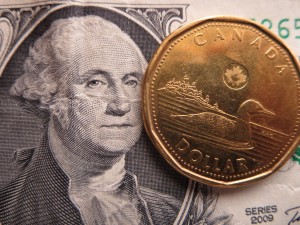The loonie takes a tumble

Compared to a U.S. greenback, the Canadian dollar is currently worth about 10 cents less. Photo: Lucy Martin
After a period of relative strength or parity, the Canadian dollar recently dropped to roughly ninety cents against one U.S. dollar. (As of Friday, at least. Rates do fluctuate.)
Those familiar with economics know the various ins and outs of such a development. For regular folks here’s how that plays out in lay terms: travel and shopping in the U.S. is now more expensive for Canadians and Canada is back “on sale” for Americans, at 10% off!
The CBC has a short “winners and losers” list here.
Why is the loonie weaker? Those who live in that world cite things like monetary policy, commodity prices and signals from regulatory agencies, as with this dissection in the Globe and Mail on Thursday:
“Until today, the Bank of Canada had been careful not to open talk down the loonie,” chief economist Douglas Porter of BMO Nesbitt Burns said late yesterday in a research note titled “BoC declares open season on loonie.”
“They effectively gave sellers the green light in today’s monetary policy report by stating that even with the big drop in recent weeks, it remained high and would still ‘pose a competitiveness challenge for Canada’s non-commodity exports,” he added.
“As if on cue, the currency promptly fell another 1 per cent on Wednesday.”
As reported by the Canadian Press, the ruling conservatives feel this can be a good thing, while political opponents say “not so fast”:
Finance Minister Jim Flaherty has made a point of noting that a weak dollar can spur economic growth by boosting exports — a boon for a government with its sights set squarely on balancing the books.
The loonie slid to 90.10 cents U.S. on Thursday, dipping briefly under the 90 cent mark for the first time since mid-2009. It’s lost four cents since Dec. 31 due to a combination of factors including a strengthening U.S. dollar, weak prices for commodities and Canada’s low-interest, low-inflation environment.
But the economy can’t turn so quickly to take advantage of a lower dollar, said NDP finance critic Peggy Nash. Many of manufacturing jobs that were lost under the Tories’ watch aren’t coming back.
The economy is underperforming and the Tories are “desperate to show that they can balance the books before the 2015 election and trying everything possible to do that,” Nash said.
For our region, the boom in cross-border Canadian shopping and travel may slow somewhat.
Meanwhile, merchants and travel destinations across Ontario and Quebec are hoping lots of Americans will return the favor of these familiar economic shifts. For now, at least, it’ll be “Come on over, your money buys more here!”
Tags: canada, economics, exchange rates, loonie, Ontario, Quebec, tourism, travel








wow the math must be getting complicated considering the us dollar is only worth 90 cents too (IF that much)